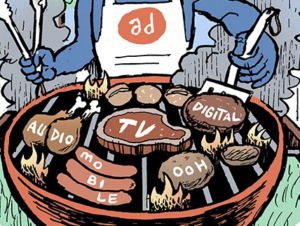“On TV And Video” is a column exploring opportunities and challenges in advanced TV and video.
Today’s column is written by Sam Armando, executive vice president, director, National Video Marketplace Intelligence, at Publicis Media.
With so many other, cheaper options, it is time to get rid of basic cable, right? Research shows that the national average traditional cable bill is $107 per month, according to Leichtman Research Group, and the No. 1 factor in people switching to other options is the lower overall cost.
So, to replace this traditional viewing, for example, let us start with a linear OTT service (vMVPD) like Sling TV, which costs only $25-$40 per month. Given I am a huge fan of “Stranger Things” and cannot wait for the second season of “Dead to Me,” I need Netflix, but that is only $16 per month. I will also need NBCUniversal’s new app for “The Office,” but that will be ad-supported and free. And with my Amazon Prime subscription, I get Amazon Prime Video for only $9 per month.
OK, all set – until the new services from Disney, Showtime, ViacomCBS, Discovery, Apple TV and HBO Max are launched. Due to the exclusive content each will offer, it is easy to see why a household will look to add them all. Once all of these are in place, the cost could easily top $100 a month, just a few dollars in savings compared to the national average cost of cable.
The primary reason consumers cut cable is cost savings, but by the time they add together the cost of all of the streaming services, they potentially could be spending just as much money. Does that decision really add up?
The number of subscription OTT video viewers continues to rise, and there is more room to grow. Just over 55% of the population, nearly 183 million people, are SVOD video users in 2019, an increase of 7% over 2018, according to eMarketer. Projections put the number at just over 197 million users by 2021, an 8% increase over this year. The only thing growing at a faster rate is the number of options these users will have in this space. With all the “hoarding” of content, one can make a case for a household to want, or need, multiple services.
The landscape is growing so rapidly that as we talk about the growth of options, we concurrently must talk about which one(s) will not survive, especially when the landscape continues to evolve with either escalating prices or the addition of advertising. Although the monthly price tag for Disney+, which tops out at $12.99, is attractive, many believe the price point is designed to draw people in, and once they are hooked, the price will rise. It would be naive to think that the other new streaming services are not employing the same strategy. Furthermore, once the prices reach a point that people find it difficult to afford them all, one has to think that the ad revenue potential for these services will be difficult to ignore. While advertisers would embrace the addition of ads, how will consumers react when ads are introduced?
While much of the focus is on how the streaming video on demand (SVOD) and ad-supported video on demand (AVOD) landscape will negatively affect broadcast ratings, we must start also putting the SVOD and AVOD players under the microscope. One thing that will not change is that there are only 24 hours in a day, and people have only so much time to consume video. When people are done with viewing the content on Netflix, Disney+, etc., how much time is left for other pay services like Starz and YouTube or free services like Pluto TV or Tubi? And that doesn’t include any of the various NFL, MLB, NBA and NHL services.
Soon, if not already, we will have to pay less attention to the number of subscribers that these services report and more to the number of viewers. As options grow, people will probably subscribe to several different streaming services, especially the free ones, but there likely will be a big difference between who has them and who watches them. We have not even begun to discuss measurement, the availability of the data and the accountability that clients will demand. As we put the pieces of this landscape together, it is easy to see that we have a way to go before it all adds up.
Follow Spark Foundry USA (@SparkFoundryUSA), Publicis Media (@PublicisMedia) and AdExchanger (@adexchanger) on Twitter.












